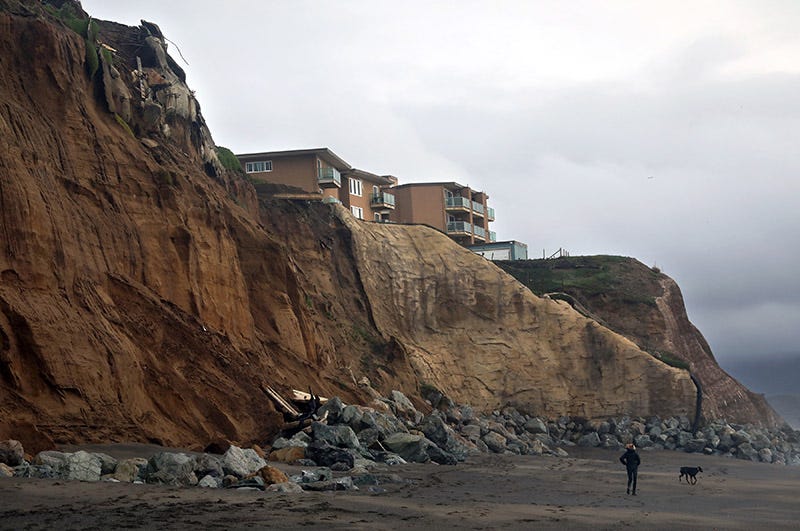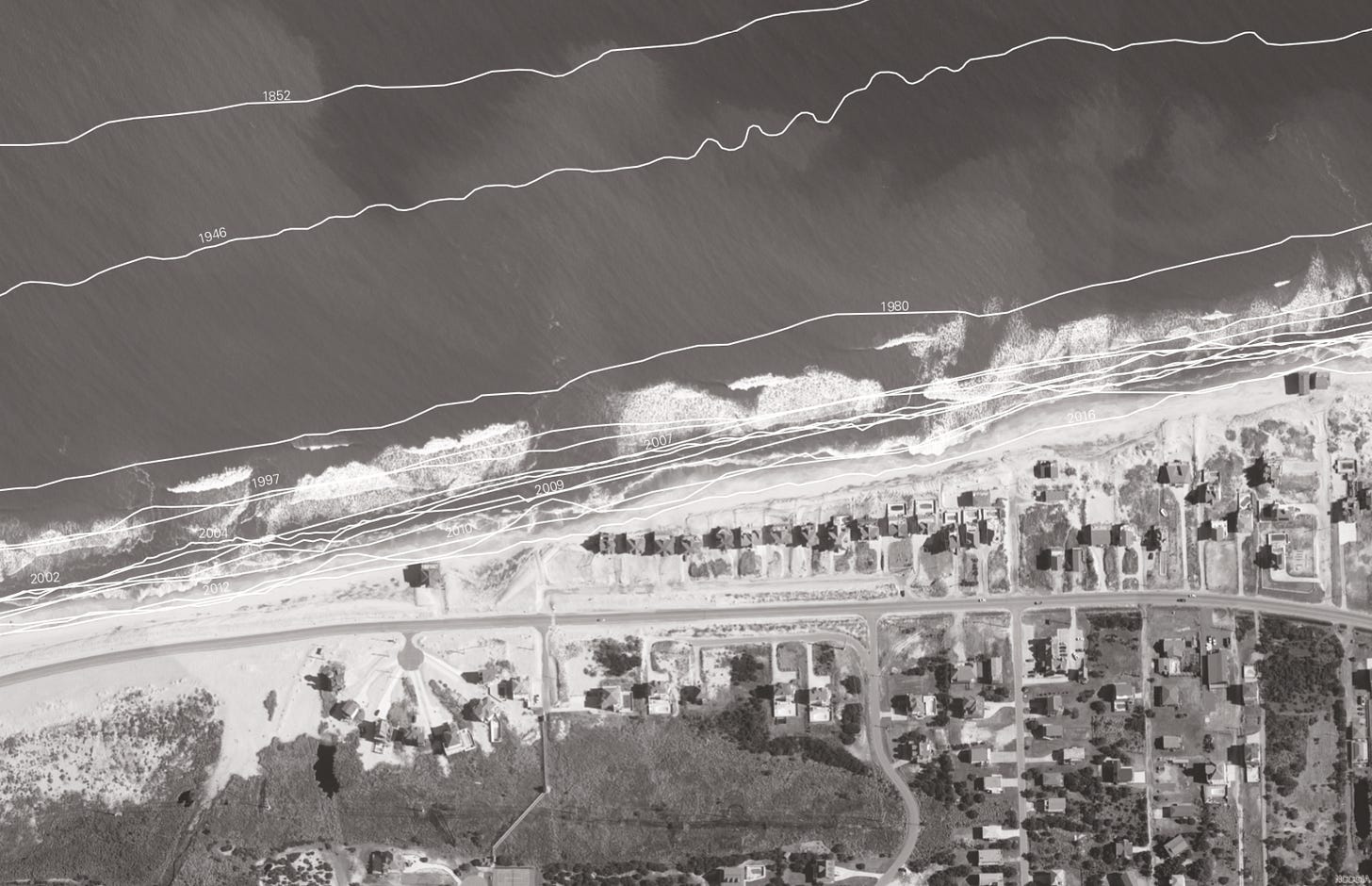#6: In The People Vs. The Sea, Can The People Win?
You don't need to own a waterfront home to understand why Sea Level Rise (SLR) and coastal erosion are big problems for everyone.
PRESSED FOR TIME?
The mental model for sea level rise is fairly binary: (i) it either concerns people because they live close to the water’s edge and see gradual change, or (ii) they find it a long run event that’s hard to conceptualise.
We all pay for sea level rise, even if we don’t own a waterfront home. Who pays for what and when will divide every coastal community in the world. The speed at which the public accepts the new realities will decide how much of our taxes go towards delaying the inevitable.
Let’s begin with a simple self-awareness test.
The picture you’re about see is from a coastal hamlet south of San Francisco, called Pacifica. Years of drought in California, followed by heavy storms in 2016 forced more than a dozen bluff-top residences to be tagged as unsafe. Why? Because the coastline below them disappeared.
Three apartment buildings — suddenly dangling off the edge — could not be saved and were demolished.
You’ll notice a few conspicuous details in this second image. The coast has been cut like a cake, with all the foundations laid bare. We don’t usually get to see the earth under our homes. Large boulders have been placed by the council along the base of the bluff, a bandaid solution to stem the speed at which the waves crash into the soil and wash it back out to sea. And lastly, a local and their dog walk along the ashen sands of the beach, probably a morning ritual that’s gone on for years while their surroundings have changed.
WHAT KIND OF PERSON ARE YOU?
Upon seeing these images, people tend to have one of three responses —
(i) An immediate interest to know more, i.e. how long it took for the coast to erode, what kind of property losses occurred, and what insurance coverage and relocation arrangements existed for the residents affected
(ii) A quick mental calculation of your distance to the ocean (one mile, ten miles, etc.), or
(iii) A fleeting interest that passes because you are well inland. In this last bucket, there’s also sometimes a moment of resentment: for much of your childhood or adult life, even visiting the sea could’ve been a rare privilege, and you might have a brief moment of schadenfreude at the misfortune of those who’ve enjoyed uninterrupted ocean views every day.
Having any of these responses doesn’t make you a good or bad person, or for that matter astute or ignorant. It simply means you’ve seen a risk and calculated your individual proximity to it.
BEHAVIOURAL SCIENCE LESSONS
The reality is people have been shown these kinds of images in focus groups for nearly three decades. The world of behavioural science has a clear understanding of how people respond to climate change in general:
We have a very strong psycho-cognitive bias to the status quo.
Politicians don’t want to tell people to transformationally adapt. Adaptation is a word people can be afraid of, because of the unknown implications of what comes next.
We don’t confront danger that’s difficult to visualise.
One person’s resilience (a flood barrier) may be another’s vulnerability (what if your flood barrier directs water faster down the street and into my home?).
If we do learn of a new technology that can solve an existential problem (i.e. a vaccine, a new carbon storage method, a laser to destroy asteroids), we succumb to excessive optimism and want to believe the challenge has been addressed.
We tend to withdraw from complex problems if a clear pathway isn’t apparent.
Polls routinely show people know climate change is real and it will affect livelihood and property, but don’t believe it will affect them personally.
“THERE’S NO ONE COMING TO THE RESCUE..“
What is climate change really asking us to conceptualise? Fixed vulnerability to moving risk. No better example of this could be found than Christopher Flavelle’s excellent front page story in the New York Times this week, on the predicament facing a small coastal community on the other side of the United States in Avon, North Carolina.
At a recent public meeting, Avon’s few hundred residents were told they needed to find $11 million just to make sure its main road didn’t wash away. Tourist beaches are shrinking at a rate of 14 feet per year in some parts of North Carolina according to local scientists, but no amount of tourism levies can offset so big an investment — and just for one piece of infrastructure like the road. As a result, some of the waterfront ratepayers are seeing their property taxes rise by nearly 50%.
The above image is from nearby Nags Head, N.C. and a vandalised, empty home on what used to be East Seagull Drive. Consider that this home used to be part of a full row of titled lots, all with good distance to the sea. Now it is the only one left standing.
Sometimes visuals are best seen from the sky. Thanks to the excellent thesis work of my Harvard colleague Isaac Stein, the rate of erosion along the North Carolina barrier islands can be shown from the two images below. The first provides a series of white lines to demonstrate the rate of the sea’s advance since 1852, 1946, 1980, 1997 and beyond; and the second layers over the certificate of ownership from March 1987, showing just how much of the land bought three decades ago has already washed into the sea.
It doesn’t matter how much is needed to repair, restore, elevate or protect: in the words of the Avon, N.C. county manager — ‘no one is coming to rescue us: we have only ourselves.’
BUT WHY DOES EVERYONE LOSE?
By now it will be clear a meaningful level of pain will be coming in many coastal communities to individual homeowners, who will find the vanishing land beneath them worth less and less. So why does it affect everyone?
As the NYT story above discussed, hurricanes over the past decade have caused $65 million in damage to Highway 12, the two-lane road that runs along the Outer Banks of North Carolina and connects Avon, Nag’s Head and many other barrier island towns to the mainland. The federal and state governments are spending an additional $155 million to replace a section of Highway 12 with a 2.4-mile bridge, as the road can no longer be protected from the ocean. The problem is the Outer Banks erode constantly, sometimes rapidly; in 2011 Hurricane Irene alone carved two new inlets into the coastline.
As the beach disappears, even a minor storm sends ocean water across Highway 12. Eventually, a hurricane will push enough water over that road to tear it up, leaving the town inaccessible for weeks or more. What occurs then? A federal emergency response, and even more dollars to rescue people we knew were in harm’s way.
Just as in our billion dollar disaster discussion, shouldn’t we ask: what else would this money buy? What is the opportunity cost of the funds we spend?
Right now, the politics of climate change redistribution hasn’t turned nasty. No politician from the American heartland asks: '‘should money be spent on a road to a small, wealthy coastal community at the expense of extra buses for elementary school routes, better pay for nurses, or opioid clinics in my economically depressed region?’ No politician is using that powerful rhetoric.. yet.
The Outer Banks remain popular to visit while the beach is there. If there is an economic benefit to be preserved, should we not preserve it? The problem is barrier islands migrate and move — nature has ordained this.
A process called over-wash moves an island slowly: longshore currents throw sediment onto the island, pushing the back bay inland and slowly migrating the ecology with it. Development in the form of concrete foundations, highways and reinforcements alters this process by creating a hard edge along the shore. Rebuilding roads and houses further disrupts and blocks sediment transfer processes, and as a result, the island gradually narrows and drowns.
So let’s ask again: who are the losers in sea level rise?
We all lose from the amenity of the beach disappearing. The homeowners lose by seeing the value of their property fall. The neighbouring communities lose by having the tourism and industry around the coast dry up.
But everyone loses when we spend taxes to maintain an unrealistic status quo, and try to stem the speed of a process that cannot be slowed.
CONCLUSION
It’s important to stress every coastline won’t undergo the same erosion. The rate of change will buy 20 to 25 good years in some locations that will eventually go the way of East Seagull Drive: that time will give us a chance to assess different solutions from the world, and potentially adapt in ways we can envisage now. But the fight over who pays for what risk is already here, and the areas of disagreement are endless:
Should I pay the same property tax increase as my beachside neighbour three blocks closer to the sea?
I don’t use the facilities that need to be rebuilt after the latest storm, why should I have to contribute?
I live near a port, military base or piece of critical water/sewer infrastructure, and these resources benefit everyone: shouldn’t the federal or state government bear a greater cost of defending this area?
The property next door is a vacation home for the owner, if they own multiple homes then why can’t they afford more?
These are questions for every coastal community in the coming decades, and there are no clear answers yet.
We will return in future Climate and Money issues to specific examples (i.e. the math and the morals) of how much real-life properties are likely to fall in value, how sea level rise plays out differently in certain settings, and what clever companies and products are devising to respond: but for now the most important idea to understand is the amount you care about any risk is usually dictated by your individual proximity to it. If you’re aware of this, it’s a big help in contextualising the costs we can’t see, but will be expected to bear.
Optimistically,
Owen C. Woolcock
3 Questions I Am Asking Myself This Week
1. MIT announced some exciting progress this week, after engineers developed self-cooling fabrics from polyethylene, a material commonly used in plastic bags. “Everyone we talked to said polyethylene might keep you cool, but it wouldn’t absorb water and sweat because it rejects water, and because of this, it wouldn’t work as a textile,” one of the researchers said. This long-held assumption might be wrong. If shown to be scalable, there’s no reason why the simple plastic bag cannot be made into fibre, used as a high-end garment, and recycled many times over.
2. In an unsexy corner of the U.S. regulatory universe, the Commodity Futures Trading Commission (CFTC) announced a new Climate Risk Unit (CRU) this week, a new body to examine the role of derivatives in understanding, pricing, and addressing climate-related risk. Though not exactly the same thing as a derivative, it’s worth remembering that the original idea for the exchange-traded fund (ETF), now a $3tr industry, started as a footnote recommendation in an SEC government paper analysing Black Monday, 1987. Could it be that a new trillion dollar climate derivative product is waiting to be created? If so, what might it look like?
3. Bill Gates released his second climate change quiz. It takes 45 seconds, give it a go! And pat yourself on the back if you get five out of five.
If You Read Or Listen To One Thing This Week
Youtube: A short video revealing the scale of the coastal erosion problem in Pacifica (CA)











